Factbook of the Grand Duchy of Krasny-Volny
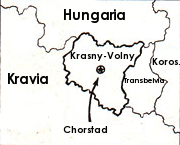

Grand Duchy of Krasny-Volny
Ducal Flag |
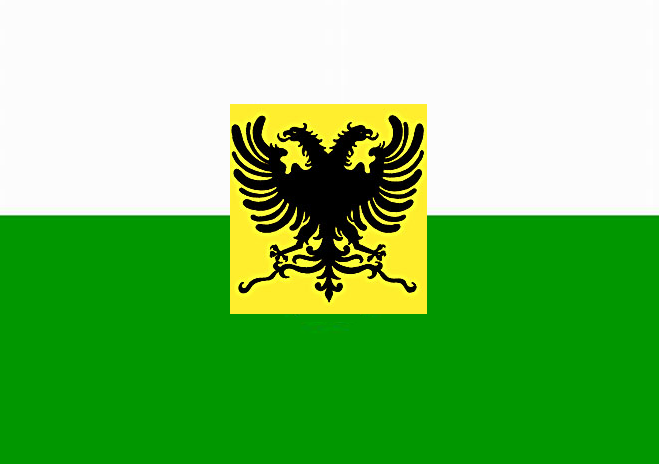 |
Contents
1. Basic Facts in Brief
2. History
1. Geography
2. Economy
4. Military
5. Government Structure and Political Structure
6. People and Population

Part One
Basic Facts in Brief
Full Nation Name: Grand Duchy of Krasny-Volny
Official Name: Most Sovereign Grand Duchy of Krasny-Volny
Short Name: Krasny-Volny
Nicknames: Krasna-Volny, Krasny
Derogatory names for Nation: 'That Aristocratic Nation of Bankers'
People from Nation are called: Krasnians
Nicknames of the people of Nation: Krasny-Volnians, Krasna-Volnans
Derogatory names for the people of Nation: None
Capital City: Chorstad
Nation's leader(s): Grand Duke Louis Saraka I
Nation Age: 810 years
Government type: Absolute Monarchy
WA official government category: Right-Wing Utopia
WA economy rating: All-Consuming
WA civil rights rating: Few
WA political freedoms rating: Unheard of
Population: 672,180
Birth Rate(?/1000): 13.6
Death Rate(?/1000): 7.39
Total land area: 5,019 sq mi
Tax rate range: 5%
GDP: $4.929 billion
GDP per capita: $139,068
Unemployment rate: .5 %
Literacy percentage: 100 %
Population Growth Rate: 0.7%
Average age of citizen: 31.4
Average lifespan of citizen: 79 years
Religion make-up of population: 84.9 % Catholic, 9.4 % Protestant, 0.6 % Orthodox, rest undeclared
Ethnicity make-up of population: Alemannic Germans 86%, Italian, Greeks, Serbs, and other 14%
Total Military (in population): 20.5 Million
Does Nation have compulsory military service: Yes
Percentage of population retired: 10.5 %
Percentage of population disabled: .4 %
Percentage of population non-working homemakers: 30 %
Do average people have a place in affecting government (such as voting): Yes
Strongest industry: Banking, Financial
Weakest industry: Automobile
How much industry regulation (absolute control, high, medium, little, none): Medium
Does Nation have any forms of slavery: No
Does Nation fight in many wars?: No
Main imports: 2
Main exports: 7
Does Nation have a space program: No
Energy sources make-up: Natural Gas 29.8 %, Electricity 29.0 %, Petrol 15.5 %, Fuel Oil 13.2 %, Diesel Oil 9.3 %, Firewood 3.0 %, Liquid gas. 0.2%
On a scale of 1-10, 10 being a wasteland, how polluted Nation: 2
How many colonies does Nation have: None
Average number of people in a household in Nation: Two adults, One child
Nation's region: Isolated Steppes
How many nations are in your region: 17
Crime Rate (high, medium, low, or none?): Low
Does Nation have companies native that have also spread to other nations?: Yes, the Bank of Krasny-Volny
Part Two
Introduction
The Grand Duchy of Krasny-Volny (Alternative Spelling: Krasna-Volny [Alemannic German: Krasnein-Volny]) is a tiny, doubly landlocked, Carthalan nation in Eastern Europe, bordered by Kravia and Austria to the west and south and by Koroscova and Transbelvia to the east. Its area is just over 13,812 km2 (about 5,019 square miles), and it has an estimated population of 620,145. Its capital is Chorstad.
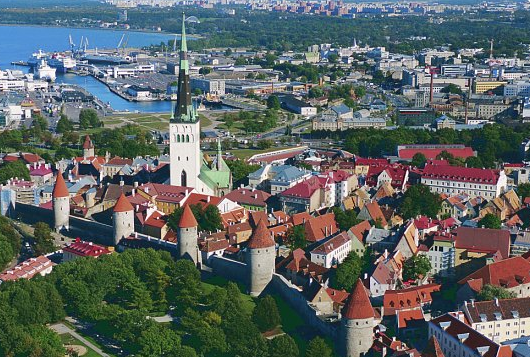
Above: Capital City, Chorstad
Krasny-Volny is one of the smallest yet the also one of richest nations in Eastern Europe and the only country to lie entirely within the Carthalan Mountains. It is also the only German-speaking country besides Liechtenstein not to share a common border with Germany. It is an absolute monarchy. Much of Krasny-Volny's terrain is mountainous, making it a winter sports destination. The country has a strong financial sector located in the capital, Chorstad, and has been identified as a tax haven. Krasny-Volny is particularly famous for its banking and the number of untraceable fortunes located within the duchy's borders.
Part Three
History
The people in Krasny-Volny are descendants of a Germanic tribe that settled in the Carthalan Mountains during the A.D. 400's. Most of the early Krasny-Volnans farmed the mountain slopes for a living. The earliest Krasny-Volnans became converts of the Roman Church, which today still shows through the Roman Catholic majority. The Krasny-Volnans had 'Romanized' and copied traditions from the Roman Empire prior to their arrival in the Carthalans, establishing one of the most organized education systems of all other Barbarian Germanic tribes. During the 900's, Krasny-Volny's ethnic population had gone on to include Magyars, Bavarians, Slavs, and Visigoths. The large number of Slavic peoples, in particular, had led to some aspects of the Krasny-Volnan language to include some Slav elements.
The capital city, Chorstad, was location of the first organized state, due to the presence of the stately Castle Chorstad there, where the ruling family of Krasny-Volny resided. It should be noted that Chorstad and most of Krasny-Volny is located within this one mountain region, Cathala, probably due to the life source found in the River Dess here. The region was shared with the neighboring peoples of Hungaria.
Krasny-Volny (At this time known as Krasna-Volny), became an established European duchy in its region, with the ruling family of Phyll represented by a heraldic symbol of a griffon and a sword. However, in the late 1100's, the Duke and his tiny kingdom were subsumed by the neighboring County of Transbelvia. In 1241, the Tartars (Mongols) invaded the neighboring nations and attacked Cathala. The Krasny-Volnans believed that the Belvians had betrayed them to the invaders, as Transbelvia more or less survived intact while Krasny-Volny was ravaged, only the Duke's old castle and the abbeys able to withstand the assault. After the Tartars had retreated, the angry people of Krasny-Volny rebelled against Transbelvia, temporarily securing their independence and restoring a Duke of Phyll to the throne. From the 1300's-1400's, Germanic immigration into Krasny-Volny was continuous from the neighbouring Austria, repopulating areas which had been destroyed by the Asiatic invaders.
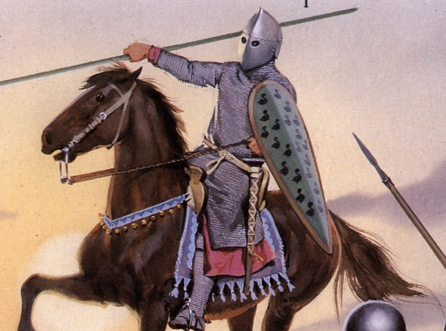
Above: Krasny Knight, circa 1100
In 1440, Krasny-Volny, Hungaria, and Transbelvia were all claimed by the Habsburgs of Austria and partially incorporated into the Holy Roman Empire. During the 1500's, the Carthalan Mountains were occupied by Hungary. The people of Cathala revolted, however, and all three nations disappeared from the maps after the bloody sixteenth century war which followed. The Hungarian control over the region was more or less exhausted and only nominal by 1623. Transbelvia and Krasny-Volny went to war again, and remained in a constant state of conflict until both were swallowed up by the encroaching Ottoman Empire in 1698. Once more, the Krasny-Volnan people blamed Transbelvia and accused them of betraying the Duke to the Turks.
The conquest by the Ottoman Empire effectively put an end to the Phyll dynasty of Krasny-Volny. It had been a monarchy under the Phylls for nearly five hundred years. The Duchy at first fought for its autonomy, but gradually was brought under Turkish rule as a semi-autonomous vassal state of the Ottoman Empire. The remaining nations of Cathala became a province of the Ottoman Empire. Much of the land was devastated by recurrent warfare, and most small settlements disappeared. Rural people living in the now Ottoman provinces could survive only in larger settlements, which were owned and protected directly by the Sultan. The Turks were indifferent to the sect of Christianity practiced by their Krasny-Volnan subjects.
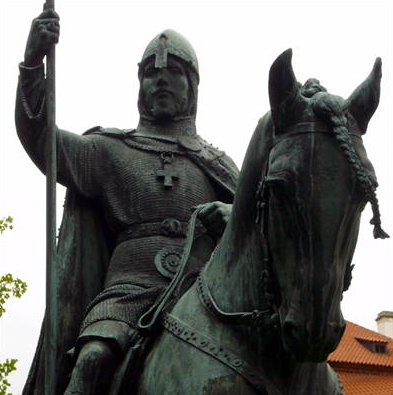
Above: Statue of Grand Duke Johann I of Krasny-Volny, Krasny champion against Transbelvia
In the 16-17th centuries German Protestant refugees arrived in Krasny-Volny to take shelter from the religious wars of the Holy Roman Empire, particularly from the repression of the Reformation in Austrian territories, then ruled by the staunchly Roman Catholic Habsburgs. Despite being accepted as a vassal kingdom, nevertheless the Krasny-Volnans refused to accept Ottoman dominance and in the 18th century raised numerous rebellions, culminating with a major Turkish defeat at the Battle of Fichellen.
The Ottoman Empire, already having lost most of Hungary to Austria and suffering from a state of decline, was forced to withdraw from Cathala, ending the Turkish occupation by 1797. Throughout the 1700's, Krasny-Volny tried to recover some measure of its lost fortune. Most of its people continued to farm for a living, although the Feudal System had long been done away with thanks to a rising middle class of traders and businessmen. In 1846, however, the Duke was overthrown by a coup staged by republican rebels, and the neighboring Kingdom of Koroscova, increasingly agitated by the constant instability in the Carthalan Mountains amongst Krasny-Volny and Transbelvia, annexed both nations after only two months of fighting. To cement his claims to the thrones of Transbelvia and Krasny-Volny, the Koroscovan king forcibly intermarried with the royal families of the two monarchies. He then proclaimed the new Kingdom of Tbliska, a united Krasny-Volny, Korosova, and Transbelvia. Alarmed by the sudden growth of power, the neighboring Hungaria and Kravia worked with the Queendom of Balkania to put an end to Koroscovan aggression. The new Kingdom of Tbliska revealed its true colors when it invaded Hungaria, and the Koroscovan armies were decisively defeated by a coalition of its neighbors.
In 1900, King Ivan II became King of Tbliska, but his government was notoriously corrupt and he was little more than a brutal tyrant, known for his ethnic cleansing policies. Under his reign, Tbliska remained neutral during World War I, although it was threatened by the Central Powers in the form of Austria-Hungary and Bulgaria, both of which tried to force Tbliska to profess a side in the conflict. When Tbliska was invaded by the Nazi forces in World War II, it fell within hours. Ivan II fled to England, and was replaced by a puppet ruler of the Third Reich. In late 1944, Tbliska was liberated by Allied armies marching through Yugoslavia and Hungary. The Koroscovan monarchists apprehended the German puppet and shot him. For days his body was hung upside down from a streetlamp in Koroscova's capital. Ravaged by the horrors of World War II, Tbliska's monarchist government was never restored, as Ivan II had died in the British Isles without leaving any heirs. Communist insurgents, later backed by the Soviet military, quickly seized the chance to murder many of the Koroscovan monarchists and set up a new government. The arrival of the first Russian troops in Cathala cemented Tbliska's fate as a Soviet Satellite State. Until 1990, Tbliska was ruled as the Socialist Federal Republic of Tbliska, which broke up with the fall of the Eastern Bloc. The Koroscovan Communist Party tried to retain control of the nation, but failed due to a spirited uprising by the Belvians and Krasny-Volnans. A war lasting from 1991 to 1993 saw Krasny-Volny free again for the first time in over a century, despite a tremendous amount of bloodshed.
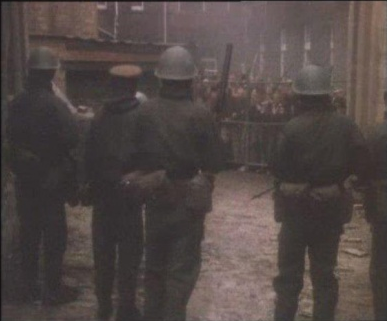
Above: Tbliskan Government Forces in the streets of Chorstad during the Riots of 1970
As Hungaria overthrew its Communist government and Kravia fought to restore its old monarchy, the troubled nations of the Carthalan Mountains become known collectively as the Krasna-Transbelvia-Koroscova Corridor. Ethnic fighting began anew between Transbelvia and Krasny-Volny in 1994, encouraged by a death squad known as the Panthers. As the war raged on between two historical enemies, many entered to exploit the opportunity for gunrunning and other illicit operations. Beset by radical Belvian guerilla groups which terrorized the countryside, Krasny-Volny's struggling new republican government salted large areas with mines.
The Belvian army soon began to emerge victorious, assisted by a mysterious female insurgent known only as Dava Sborsc, who derailed shipments of Krasny weapons and assassinated high-ranking military officers. Her last recorded activities included destroying an arms shipment led by an unknown international terrorist and an army of mercenaries, a shipment personally supervised by Krasny commander Dvak Tvorakovich, whom Sborsc accused of murdering entire mountain villages of innocent Belvians. Eventually, angry with the bloody war and enraged at the overtaxing by the new republic, hundreds of Krasny-Volnans stormed the government offices. A provisional government declared a truce with Transbelvia, and President Helmut Pristini of the Republic of Krasny-Volny was imprisoned.
An uneasy coalition quickly formed to lead the new country. A decision was made to write a new constitution was written to lead the nation through this new Post-Communism era. After a significant, yet short, debate, the religious and civilian leadership overruled the military and decided to make the new government a monarchy again. They viewed installing a strong leader, the Duke, as the only way to guide the nation through this crisis. The debate to choose the new Duke was short, yet vicious. Many contenders rose to attempt to claim the title. Military, religious, and civilian leaders all vied for the title. It soon became apparent that there could be no one from any of those groups chosen to take up the mantle of monarch. Luckily, it was recently learned that a descendant of the House of Phyll, which was the dynasty that ruled Krasny-Volny before its virtual conquest by the Ottoman Empire was still living in the nation with his family. Once he was discovered, leaders from all sides immediately sought him out in an attempt to end the row between the various groups, so the new government could be formed. Military leaders disagreed with the idea of a hereditary ruler, but greatly preferred that to a democratic republic. Though well-aware of his current role in these power struggles, he reluctantly accepted the title. The first Duke of Krasny-Volny since 1846 was crowned as Leon III of Krasny-Volny in St. Faustina's Cathedral, Chorstad. As an absolute monarch, Leon III granted Krasny-Volny a limited constitution approved by the ducal government. Reduced nearly to bankruptcy following the chaos of the recent wars with Transbelvia, the Duke often resorted to selling family treasures and priceless historical artifacts to get by. Krasny-Volny prospered, however, as it managed to survive through the next few years long enough to use its low corporate tax rates to draw many foreign companies to the country.
Part Four
Geography
The River Dess flows along the western border of Krasny-Volny. Narrow strips of excellent farmland lie next to the river. Snow-topped mountains cover most of Krasny-Volny's terrain. Many of these mountain slopes are dotted with pine forests and grazing meadows for livestock. Only grass grows further up the mountainsides. Steep mountain peaks as high as 10,000 feet above sea level tower over the valleys of Krasny-Volny.
Krasny-Volny has a mild climate. Warm spring winds sweep over the nation and make it ideal for gardens. The average yearly temperature is 40 degrees F. Precipitation averages about 35 inches per year.
Part Five
Economy
Commerce and manufacturing account for most of Krasny-Volny's economy. Ceramics and dairy goods are chief products. Tourism also contributes much to the economy, as Chorstad's ancient buildings and beautiful mountains are main attractions.
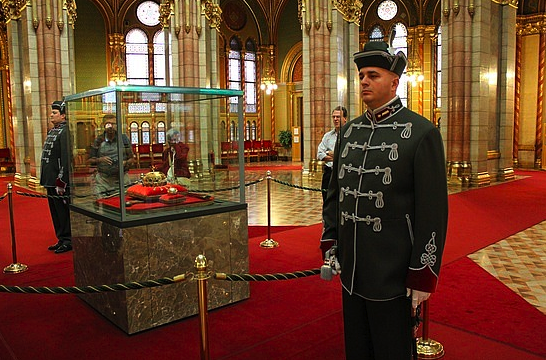
Above: Royal Museum of History, Chorstad
Ski slopes have been opened by the Duke in various locations. Tourists can buy European wines, Swiss wristwatches, and other goods at low prices in Krasny-Volny, because import duties are so low. The banking sector, with its tax haven status, also contributes substantially to the economy.
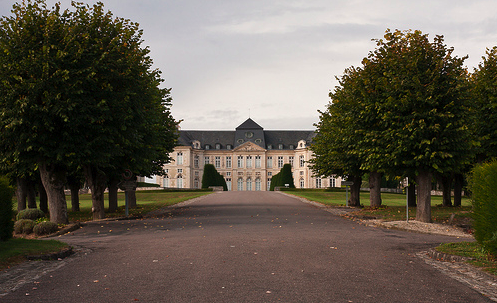
Above: Bank of Krasny-Volny, Chorstad Location
Many foreign corporations have headquarters in Chorstad, mainly due to the low taxation there. Hotels and casinos are mainly regulated by the Duke and his government. Many wealthy foreigners come to live in Krasny-Volny because of the almost nonexistent income tax. Chorstad is now regarded by many to be virtually one large tourist resort, with luxury inns, clubs, flower gardens, and places of entertainment.
Part Six
Military
The Krasny-Volnan Armed Forces are composed of an army, navy, air force, and a special forces component. As of 2009 it is organized as a fully professional standing army under the Ministry of Defence with the aim of protecting and defending Krasny sovereignty. The military currently maintains a force of 5,400 active duty members. Conscription has been introduced, but is only very loosely enforced.
Over time, Krasny-Volny's defense industries have maintained and refurbished a full monopoly of ground, air, and nonconventional weapons. Although it lags at least two generations behind the state of the art in most to all systems, the local military-industrial complex has adapted, upgraded, or modified hardware in virtually every main category of equipment.
By its own estimate, the KVAF at present has some 60 main battle tanks in its inventory, including 10 T-64s, 38 T-55s and altered T-62s, some deteriorating T-34s of World War II vintage, and 19 PT-76s. Numerically, the Soviet T-55 and its T-54 variants still dominate the force and Krasny-Volny is content to continually maintain rather than retire them. KVAF battalions also operate a range of light armored fighting vehicles, and deploys up to 200. As with tanks, the majority deployed (113 BMP-1s) are old, although during the 2000s Krasny-Volnan procurement agencies began acquiring a series of BMP-3M IFVs. Eighty older Western armored cars, including the Panhard AML-90 by Sofema and the Brazilian EE-9 Cascavel, have also been accepted as aid from Kravia. The Panhards were re-engined with diesel motors in Kravian service. While an impressive advance for Krasny LAVs and the first to incorporate laser targeting and optics, they are still no match for advanced NATO MBTs.
Ranks of the Krasny Military in Ascending Order:
1. Honvéd (Private)
2. Gefreiter (Private First Class)
3. Korporal (Corporal)
4. Zugsführer (Sergeant)
5. Feldwebel (Master Sergeant)
6. Stabs-Feldwebel (Sergeant Major)
7. Offiziersstellvertreter (Warrant Officer)
8. Leutnant (Second Lieutenant)
9. Oberleutnant (First Lieutenant)
9. Hauptmann (Captain)
10. Őrnagy (Major)
11. Oberstleutnant (Lieutenant Colonel)
12. Oberst (Colonel)
13. Vezérőrnagy (Major General)
14. Feldmarschallleutnant (Lieutenant General)
15. General der Infanterie (General; Infantry Forces)
16. Feldzeugmeister (General; Artillery and Armored Forces)
17. Generaloberst (Colonel General)
18. Feldmarschall (Field Marshall)
Part Seven
Government
Krasny-Volny is a duchy (Ruled by a Duke). The Grand Duke represents Krasny-Volny in international affairs, such as the signing of treaties and agreements with other nations. The Duke is head of government, and when he dies the throne is passed to the Duke's eldest son. Laws must be approved by the Duke. 10 members of a National Assembly are elected to five-year terms. Any act they propose must be approved by the Duke or one of his personal officials. The chairman of the National Assembly usually represents the Duke and approves all members of the Assembly before they can take their place as a member of that body.
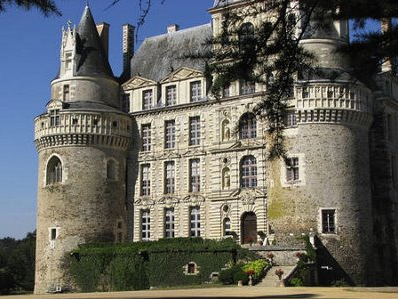
Above: The Grand Duke's stately residence, overlooking Chorstad
The Duke's personal officials and ministers are those that hold some of the highest offices in Krasny-Volny's government. They may serve permanent terms if approved to do so by the Grand Duke. Before they are approved however, they must be nominated by the National Assembly. Despite the National Assembly and the Constitution, Krasny-Volny is essentially an absolute monarchy, since every member of the Assembly must be approved by the Duke and the monarch maintains the ability to fire the government or do away with the Constitution.
Part Eight
People and Population
In order to become a citizen of Krasny-Volny, one's grandparents and parents must have been born there. Foreigners must live there ten years, and then apply for citizenship. The local community around them decides whether they obtain citizenship by voting. If even one blackballs the foreigner, he will be denied. Only a few Krasny-Volnans farm for a living. The rest choose to live as factory workers or specialized craftsmen. Most of the people are Protestants or Roman Catholics.
Krasny children are required to go to school, but age limits may vary. In Chorstad, children must attend school from age 6 to 15. Secondary and Primary Schooling are both free, but barred to foreigners. Private schooling institutions do, however, offer education for foreigners who wish to be educated in Krasny-Volny. There is an institute for technical sciences in Chorstad.

